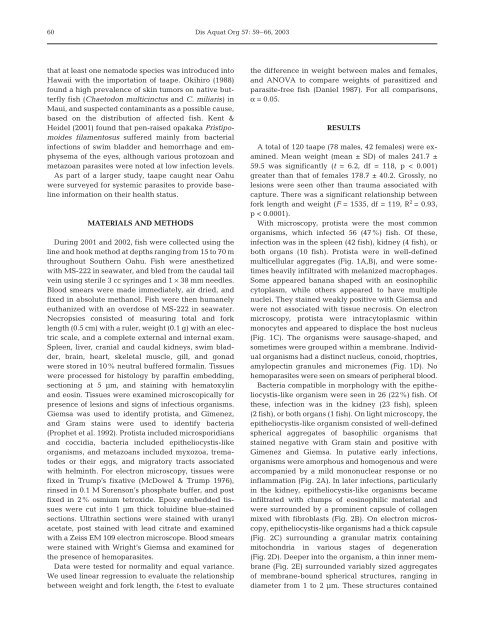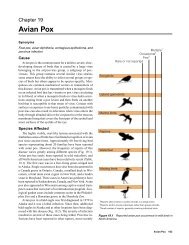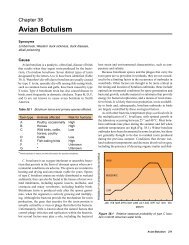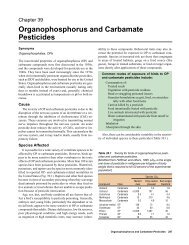Protozoal and epitheliocystis-like infections in the introduced
Protozoal and epitheliocystis-like infections in the introduced
Protozoal and epitheliocystis-like infections in the introduced
You also want an ePaper? Increase the reach of your titles
YUMPU automatically turns print PDFs into web optimized ePapers that Google loves.
60<br />
Dis Aquat Org 57: 59–66, 2003<br />
that at least one nematode species was <strong>in</strong>troduced <strong>in</strong>to<br />
Hawaii with <strong>the</strong> importation of taape. Okihiro (1988)<br />
found a high prevalence of sk<strong>in</strong> tumors on native butterfly<br />
fish (Chaetodon multic<strong>in</strong>ctus <strong>and</strong> C. miliaris) <strong>in</strong><br />
Maui, <strong>and</strong> suspected contam<strong>in</strong>ants as a possible cause,<br />
based on <strong>the</strong> distribution of affected fish. Kent &<br />
Heidel (2001) found that pen-raised opakaka Pristipomoides<br />
filamentosus suffered ma<strong>in</strong>ly from bacterial<br />
<strong><strong>in</strong>fections</strong> of swim bladder <strong>and</strong> hemorrhage <strong>and</strong> emphysema<br />
of <strong>the</strong> eyes, although various protozoan <strong>and</strong><br />
metazoan parasites were noted at low <strong>in</strong>fection levels.<br />
As part of a larger study, taape caught near Oahu<br />
were surveyed for systemic parasites to provide basel<strong>in</strong>e<br />
<strong>in</strong>formation on <strong>the</strong>ir health status.<br />
MATERIALS AND METHODS<br />
Dur<strong>in</strong>g 2001 <strong>and</strong> 2002, fish were collected us<strong>in</strong>g <strong>the</strong><br />
l<strong>in</strong>e <strong>and</strong> hook method at depths rang<strong>in</strong>g from 15 to 70 m<br />
throughout Sou<strong>the</strong>rn Oahu. Fish were anes<strong>the</strong>tized<br />
with MS-222 <strong>in</strong> seawater, <strong>and</strong> bled from <strong>the</strong> caudal tail<br />
ve<strong>in</strong> us<strong>in</strong>g sterile 3 cc syr<strong>in</strong>ges <strong>and</strong> 1 × 38 mm needles.<br />
Blood smears were made immediately, air dried, <strong>and</strong><br />
fixed <strong>in</strong> absolute methanol. Fish were <strong>the</strong>n humanely<br />
euthanized with an overdose of MS-222 <strong>in</strong> seawater.<br />
Necropsies consisted of measur<strong>in</strong>g total <strong>and</strong> fork<br />
length (0.5 cm) with a ruler, weight (0.1 g) with an electric<br />
scale, <strong>and</strong> a complete external <strong>and</strong> <strong>in</strong>ternal exam.<br />
Spleen, liver, cranial <strong>and</strong> caudal kidneys, swim bladder,<br />
bra<strong>in</strong>, heart, skeletal muscle, gill, <strong>and</strong> gonad<br />
were stored <strong>in</strong> 10% neutral buffered formal<strong>in</strong>. Tissues<br />
were processed for histology by paraff<strong>in</strong> embedd<strong>in</strong>g,<br />
section<strong>in</strong>g at 5 µm, <strong>and</strong> sta<strong>in</strong><strong>in</strong>g with hematoxyl<strong>in</strong><br />
<strong>and</strong> eos<strong>in</strong>. Tissues were exam<strong>in</strong>ed microscopically for<br />
presence of lesions <strong>and</strong> signs of <strong>in</strong>fectious organisms.<br />
Giemsa was used to identify protista, <strong>and</strong> Gimenez,<br />
<strong>and</strong> Gram sta<strong>in</strong>s were used to identify bacteria<br />
(Prophet et al. 1992). Protista <strong>in</strong>cluded microsporidians<br />
<strong>and</strong> coccidia, bacteria <strong>in</strong>cluded <strong>epi<strong>the</strong>liocystis</strong>-<strong>like</strong><br />
organisms, <strong>and</strong> metazoans <strong>in</strong>cluded myxozoa, trematodes<br />
or <strong>the</strong>ir eggs, <strong>and</strong> migratory tracts associated<br />
with helm<strong>in</strong>th. For electron microscopy, tissues were<br />
fixed <strong>in</strong> Trump’s fixative (McDowel & Trump 1976),<br />
r<strong>in</strong>sed <strong>in</strong> 0.1 M Sorenson’s phosphate buffer, <strong>and</strong> post<br />
fixed <strong>in</strong> 2% osmium tetroxide. Epoxy embedded tissues<br />
were cut <strong>in</strong>to 1 µm thick toluid<strong>in</strong>e blue-sta<strong>in</strong>ed<br />
sections. Ultrath<strong>in</strong> sections were sta<strong>in</strong>ed with uranyl<br />
acetate, post sta<strong>in</strong>ed with lead citrate <strong>and</strong> exam<strong>in</strong>ed<br />
with a Zeiss EM 109 electron microscope. Blood smears<br />
were sta<strong>in</strong>ed with Wright’s Giemsa <strong>and</strong> exam<strong>in</strong>ed for<br />
<strong>the</strong> presence of hemoparasites.<br />
Data were tested for normality <strong>and</strong> equal variance.<br />
We used l<strong>in</strong>ear regression to evaluate <strong>the</strong> relationship<br />
between weight <strong>and</strong> fork length, <strong>the</strong> t-test to evaluate<br />
<strong>the</strong> difference <strong>in</strong> weight between males <strong>and</strong> females,<br />
<strong>and</strong> ANOVA to compare weights of parasitized <strong>and</strong><br />
parasite-free fish (Daniel 1987). For all comparisons,<br />
α = 0.05.<br />
RESULTS<br />
A total of 120 taape (78 males, 42 females) were exam<strong>in</strong>ed.<br />
Mean weight (mean ± SD) of males 241.7 ±<br />
59.5 was significantly (t = 6.2, df = 118, p < 0.001)<br />
greater than that of females 178.7 ± 40.2. Grossly, no<br />
lesions were seen o<strong>the</strong>r than trauma associated with<br />
capture. There was a significant relationship between<br />
fork length <strong>and</strong> weight (F = 1535, df = 119, R 2 = 0.93,<br />
p< 0.0001).<br />
With microscopy, protista were <strong>the</strong> most common<br />
organisms, which <strong>in</strong>fected 56 (47%) fish. Of <strong>the</strong>se,<br />
<strong>in</strong>fection was <strong>in</strong> <strong>the</strong> spleen (42 fish), kidney (4 fish), or<br />
both organs (10 fish). Protista were <strong>in</strong> well-def<strong>in</strong>ed<br />
multicellular aggregates (Fig. 1A,B), <strong>and</strong> were sometimes<br />
heavily <strong>in</strong>filtrated with melanized macrophages.<br />
Some appeared banana shaped with an eos<strong>in</strong>ophilic<br />
cytoplasm, while o<strong>the</strong>rs appeared to have multiple<br />
nuclei. They sta<strong>in</strong>ed weakly positive with Giemsa <strong>and</strong><br />
were not associated with tissue necrosis. On electron<br />
microscopy, protista were <strong>in</strong>tracytoplasmic with<strong>in</strong><br />
monocytes <strong>and</strong> appeared to displace <strong>the</strong> host nucleus<br />
(Fig. 1C). The organisms were sausage-shaped, <strong>and</strong><br />
sometimes were grouped with<strong>in</strong> a membrane. Individual<br />
organisms had a dist<strong>in</strong>ct nucleus, conoid, rhoptries,<br />
amylopect<strong>in</strong> granules <strong>and</strong> micronemes (Fig. 1D). No<br />
hemoparasites were seen on smears of peripheral blood.<br />
Bacteria compatible <strong>in</strong> morphology with <strong>the</strong> <strong>epi<strong>the</strong>liocystis</strong>-<strong>like</strong><br />
organism were seen <strong>in</strong> 26 (22%) fish. Of<br />
<strong>the</strong>se, <strong>in</strong>fection was <strong>in</strong> <strong>the</strong> kidney (23 fish), spleen<br />
(2 fish), or both organs (1 fish). On light microscopy, <strong>the</strong><br />
<strong>epi<strong>the</strong>liocystis</strong>-<strong>like</strong> organism consisted of well-def<strong>in</strong>ed<br />
spherical aggregates of basophilic organisms that<br />
sta<strong>in</strong>ed negative with Gram sta<strong>in</strong> <strong>and</strong> positive with<br />
Gimenez <strong>and</strong> Giemsa. In putative early <strong><strong>in</strong>fections</strong>,<br />
organisms were amorphous <strong>and</strong> homogenous <strong>and</strong> were<br />
accompanied by a mild mononuclear response or no<br />
<strong>in</strong>flammation (Fig. 2A). In later <strong><strong>in</strong>fections</strong>, particularly<br />
<strong>in</strong> <strong>the</strong> kidney, <strong>epi<strong>the</strong>liocystis</strong>-<strong>like</strong> organisms became<br />
<strong>in</strong>filtrated with clumps of eos<strong>in</strong>ophilic material <strong>and</strong><br />
were surrounded by a prom<strong>in</strong>ent capsule of collagen<br />
mixed with fibroblasts (Fig. 2B). On electron microscopy,<br />
<strong>epi<strong>the</strong>liocystis</strong>-<strong>like</strong> organisms had a thick capsule<br />
(Fig. 2C) surround<strong>in</strong>g a granular matrix conta<strong>in</strong><strong>in</strong>g<br />
mitochondria <strong>in</strong> various stages of degeneration<br />
(Fig. 2D). Deeper <strong>in</strong>to <strong>the</strong> organism, a th<strong>in</strong> <strong>in</strong>ner membrane<br />
(Fig. 2E) surrounded variably sized aggregates<br />
of membrane-bound spherical structures, rang<strong>in</strong>g <strong>in</strong><br />
diameter from 1 to 2 µm. These structures conta<strong>in</strong>ed
















